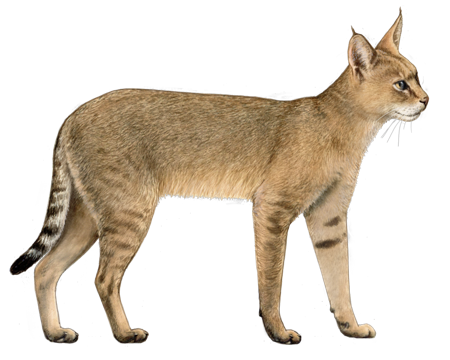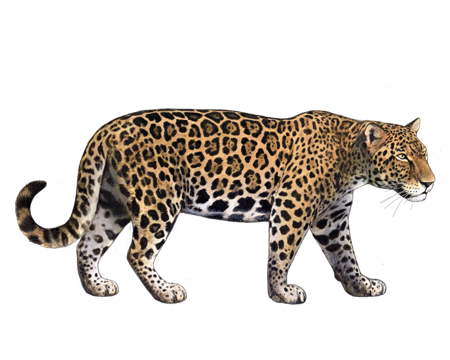
Jungle Cat
Jungle Cats are adaptable, medium-sized wild cats that live in wetlands throughout the Nile River Valley parts of Asia.
Interested in discovering if your cat is a Jungle Cat?
Check out Wisdom Panel's DNA test.
Jungle Cat Traits
General Appearance
Jungle Cats have a slender build and long legs, and they weigh between 11-20 pounds.
Coat and Colouring
The Jungle Cat's coat ranges from sandy brown to reddish to gray. They have brown stripping on their legs and dark rings on their black-tipped tails. Kittens are born with stripes that help hide them from danger, but these disappear as they mature.
Distinctive Physical Traits
Jungle Cats have large claws on both their front and back paws that help them easily scale trees. Other distinguishing features include a narrow head, high-domed forehead, tall, rounded ears, and yellow eyes.
Jungle Cat Temperament
Unless it's breeding season, Jungle Cats are typically solitary animals. However, families consisting of a male, female, and kittens have been spotted in the wild.
Jungle Cats are not nocturnal and usually hunt during the early morning or late afternoon. Like the domestic cats we know and love, they enjoy sunbathing. But unlike the typical house cat, they like to swim and dive. Other common behaviors include rubbing on objects to mark their territory and communicating through meows, purrs, hisses, growls, and barks.
If kept domestically, these cats require a quiet household and an outdoor enclosure to roam freely.
Jungle Cat History
Despite their name, Jungle Cats don't typically inhabit jungles. Also known as Reed Cats and Swamp Cats, they live in densely planted wet habitats in Egypt, India, and other parts of South and Southeast Asia.
Ancient Egyptians used Jungle Cats to hunt birds. Like other African and domestic cats, Jungle cats appeared in Egyptian art, and archeologists have found their mummified remains buried in tombs.
Breeders have used Jungle Cats to create hybrid cat breeds, including the Chausie (an Abyssinian cross) and the Jungle Bob (a Pixiebob cross). In some places, people may own a Jungle Cat—provided they follow the rules and restrictions for exotic cat ownership.
Though their population is declining due to habitat loss, hunters, and fur traders, Jungle Cats are not an endangered species.
Jungle Cat Care
Nutrition
The Jungle Cat's diet consists primarily of rodents, but they also eat birds, reptiles, insects, wild pigs, and amphibians. Thanks to their strong swimming skills, they can even dive to catch fish.
Grooming
Jungle Cats groom themselves to keep clean and remove their scent—which keeps potential prey from smelling them.
Health
Jungle Cats need many of the same vaccinations and preventive care as domestic cats when kept in captivity. However, they require a veterinarian trained and licensed in exotic animal care.
Breed Group
Wild cat
The breeds and populations in this group are, as the name would imply, still considered wild and undomesticated. The Wild Cat Group incorporates the widest range of body sizes and natural habitats of all the breed groups.
Resources
https://www.catsforafrica.co.za/jungle-cat-felis-chaus/
https://bigcatrescue.org/jungle-cat-facts/
https://wildcatconservation.org/wild-cats/asia/jungle-cat/
http://animalia.bio/jungle-cat
https://pethelpful.com/exotic-pets/small-exotic-cats
Reviewed 23 February 2021 by Annette Louviere, DVM

















